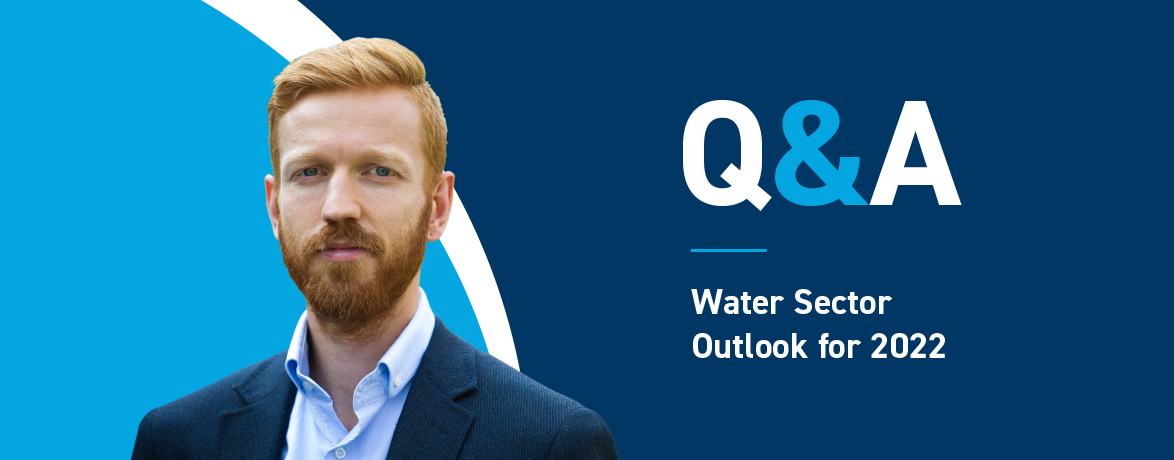Water Sector Outlook for 2022: Q&A with XPV’s Sam Saintonge

What’s next for the water sector? In this Q&A, XPV Water Partners’ Sam Saintonge offers his thoughts on how the pandemic, climate change, and the ever-present challenge to do more with less will shape our industry in 2022.
Q: How do you see COVID impacting the water sector in the coming year?
Saintonge: The pandemic has really underscored ongoing challenges for our sector. More people are retiring, there are bigger needs for infrastructure to meet demand and adapt to new conditions, and everyone is experiencing tighter budgets. Innovation is going to help utilities to do more with less. With more people working from home more often, we’re going to see more utilities adopting digital solutions and safely storing data in the cloud. We’ll also see more utilities looking to achieve greater outputs from existing footprints, rather than building bigger plants and pipes to meet demand.
Empowering utilities to make better, faster decisions about their systems is part of how our sector is building resilience. We’re seeing that the companies in our portfolio that offer innovative digital water solutions, including combinations of AI, machine learning, instrumentation, and sensing – Metron-Farnier, Metasphere, SmartCover, Mobiltex, and LuminUltra, for example – are experiencing significant growth for this reason.
Q: What are some of the other trends that will influence investment in water technologies this year?
Saintonge: Tackling climate change is the biggest driver for investment. It’s linked to everything.
Both the COP26 Agreement and the IPCC report issued urgent calls for the world to mitigate and adapt. Many of the wealthier countries are responding with mandates and funding that focus on resilience, especially in regions that have experienced the impacts. Whether we’re dealing with drought, extreme flooding, or biodiversity, water is central to resilience.
And we’re finally starting to see the money flow to improve infrastructure, tackle sewage pollution and contaminants, and use water more efficiently. For one example, President Biden recently passed an historic US $1.4T infrastructure bill which includes a significant allocation to further accelerate the adoption of innovative technologies in the country’s water and wastewater market. It’s a huge boost for the sector.
Related to climate change, utilities are making a huge push toward achieving net zero carbon footprint. At the same time, they’re diving deeper into life-cycle costing and trying to do more with less. These themes are linked. It means customers are no longer looking for the cheapest solutions – when they make their purchases, they’re factoring in things like energy efficiency, robust digital decision-making tools, operating costs, and lifetime costs. Isle Utilities, an innovation consulting firm and one of our portfolio companies, has indicated a growing percentage of its team’s work is focused on helping utilities develop and deploy strategies that will achieve these goals.
For many industrial end users, water is a looming risk factor. Every day, these customers are becoming more acutely aware of the challenges posed by climate change and water availability.
The global microchip shortage, which is impacting supply chains across industries, begins to illustrate the magnitude of the problem – and the opportunity to innovate. We use microchips to manufacture everything from phones to fridges to cars, but making chips requires a huge volume of treated water. Taiwan, one of the world’s top chip producers, is currently facing one of the worst droughts in its history. As part of efforts to manage the country’s water shortage, Taiwan Semiconductor Manufacturing Co. is spending millions on water recycling solutions to avoid relying on trucking in water to keep its plants running. The new plant will be the world’s first advanced treatment centre for industrial wastewater. Other manufacturers, including Intel and its plants in the United States, are also announcing initiatives to make more efficient use of water resources.
Water is not only a priority for these businesses; it’s also on the minds of investors. Industry has never been more motivated to adopt innovative solutions to help manage acute and future risks.
Q: What makes you most excited about the water sector in 2022?
Saintonge: Seeing the changes in our industry and making progress. Traditionally, the water sector has been slow to adopt new technologies. Over the past few years, our portfolio companies have experienced significant growth. For XPV, this signals that the sector sees the value in what we’re offering and is starting to build trust in innovation. What’s more is that we’re part of a tightly knit industry. When customers are happy and satisfied with a technology, they tend to share the good news.
As the sector continues to mature, we’re seeing new opportunities for investment and acquisition. Boomers are retiring and new founders are bringing disruptive ideas to the table. We also continue to meet founders who want to accelerate the growth of their business but need support from partners like XPV to make it happen. As well, a lot of very smart people that have done well in the water sector and want to get back to working with smaller emerging companies. We can help make these connections and re-deploy the talent.
As well as retaining people with valuable experience and skills, it’s hugely promising that water companies are attracting new and extraordinary talent from outside the sector. People want to make a difference and working in water innovation is a fantastic way to have a positive impact. It’s shaping up to be an exciting year!